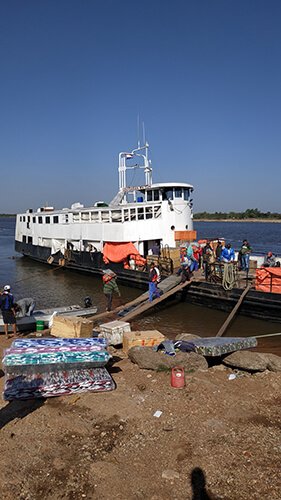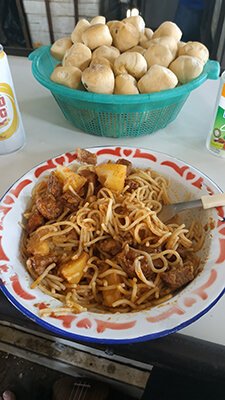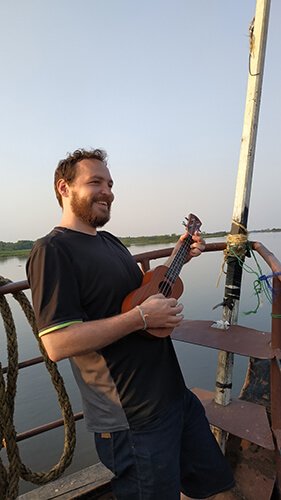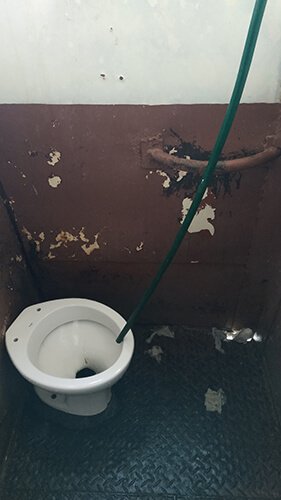If you’re looking for unique experiences when you travel, the Aquidaban in Paraguay should be high up on your list.
Paraguay is full of unique experiences. We already talked about the awesome places to stay in Paraguay in the last post. The Aquidaban could easily have made that list, but I thought it deserved its own special mention.

For those of you who are unaware, let me answer every conceivable question:
Table of Contents
What is the Aquidaban?
The Aquidaban is a market boat that runs from Concepcion, up the Paraguay River, and finishes in Bahia Negra near the triple frontier of Paraguay, Brazil and Bolivia.

It stops at the relatively big ports of Valle-Mi and Fuerte Olimpo, but also at every tiny little village too.
Built in 1930, it serves as a lifeline for the villages and towns along the Paraguay River. While some have access by road, when it rains these roads become completely impassable. Without the Aquidaban and a couple of other boats that ride the river, they’d be stranded with no supplies.
What kind of goods do they deliver? Anything you can imagine! Fruit, veg, beer, mattresses, motorbikes… if they need it, the boat brings it.
How much cargo do they transport? Up to 80 tonnes! That does not include the 100+ passengers which make the regular journey back and forward.
How long and how much?
Before we (myself and Steve, an American friend) decided to take the ride we researched as much as possible. There were a few short videos and write-ups, but most were from 3/4/5 years ago. There was very little current information.
The journey from Concepcion to Bahia Negra takes 3.5 days. You can jump off the boat at any of the stops and the price will lower accordingly.
Buy your tickets from the tiny little ticket office at the port in Concepcion. If you want a cabin it’s recommended to reserve it in advance.
The boat leaves Concepcion at 11 am on Tuesday mornings and arrives in Bahia Negra early Friday morning.
It returns from Bahia Negra on Friday 11:30 and arrives back in Concepcion early on Sunday morning.
The price for the entire 3.5-day journey is 130,000PYG ($20). That covers just the trip. Then you have sleeping options:
- Sleeping on the hard plastic bench: Free
- Hammock: 40,000PYG ($6.20)
- Cabin: 100,000PYG ($15.50) Fits up to 4 people and the price is for the cabin not per person.
The hard benches offer very little luxury. As you’ll be clutching your belongings all night this won’t be the most peaceful sleep ever. The first night is usually pretty packed so there’s a chance you’ll be squashed in, sleeping upright. I’ve slept in some rough spots before, but I wouldn’t fancy this.
The hammocks add an extra layer of comfort. During the daytime they’re either packed away or tied up out of reach to allow free movement around the boat. Depending on how many people are sleeping in them, there are a comical amount of hammocks tied to every available pole. 
The cabin is where the party’s at! This is the option we chose and I regret nothing. While it almost doubled the price of the trip, we had a bed and a roof over our heads. When I say bed, it was more like sleeping in a prison cell, but at least we had security, right?

We had a door. Good start. The door, however, didn’t lock. This was a bit of a pain until we got the rhythm of the boat. With a bit of string and boy scout knowledge we were able to rig a locking system. This came in handy whenever we needed to leave the cabin.
Our big bags were jammed under the bottom bunk making it all but impossible for a light-fingered thief to slip in and out. All other valuables were kept on our person or in a day bag.
Was all that security necessary?
Is it safe to travel on the Aquidaban?
People are coming and going at every stop, goods are being loaded and unloaded and new faces are popping up all the time.

While I’m quite sure casual, opportunistic theft does happen occasionally, at no point on the entire trip did I feel nervous. If you exercise common sense and don’t flash your expensive goods around or leave them lying around, you’ll be fine.
Tourists travelling on the boat are quite rare, but not unheard of. A few people completely ignored us and didn’t make eye contact, but everyone else was super friendly.
The Captain and crew are always somewhere to be found, so if something were to happen I imagine they would not be pleased. This boat is their livelihood. If they were to receive negative publicity due to theft or assault, their cabins could soon be empty.
But more than any of that, Paraguayans, on the whole, are lovely people! I’m not saying every single one is a saint but, as a people, I found them to be warm, friendly, welcoming, incredibly trusting (we were given the keys to a house after meeting a guy for 1 night) and very respectful.
They’re a proud people who love to tell stories and share their culture. For more information on that read my post on if Paraguay is worth visiting.
What is there to do on the Aquidaban?
If you’re looking for an 18 to 30s party boat, keep looking. You won’t find it here.
When it’s time to pull in to port and load/unload it gets a bit lively. It can be fun to find a good spot and watch the transfer of goods. A word of warning, don’t get in the way! They run a tight operation and don’t take kindly to curious camera-waving tourists getting in the way.
Lunchtime and dinner time see a little bit of commotion as people rush to the kitchen area. It’s wise to pre-order your food to guarantee you get a plate. The meals aren’t mind-blowing, but they’re certainly belly-busting. It’s either rice or pasta and meat. Servings are generous and, if combined with the local bread – Galleta Cuartel, you’ll need some serious belly rubbing time afterwards.

I think the Galleta Cuartel deserves a special mention too. It’s a scientific miracle how they created a bread so dry, so utterly devoid of moisture that I felt dehydrated just holding it. It’s perfect for the Chaco where refrigeration isn’t always possible. Normal bread would be mouldy in days, but this stuff? This will outlast the human race!
- Breakfast of coffee and Galleta cuartel: 10,000
- Hot meal: 15,000
- Beer: 5,000
Apparently you can buy food from the market sellers on the ground floor but we never had any joy.
At night, silence descends.
The sunsets seem to last forever and you can get some incredible shots.

Once the sun goes down you can either retire to your bench/hammock/cabin, or you can sit on the bow of the ship and chat with the locals. We chose this option every night.
The passengers are always rotating so you meet new people all the time. While some are shy, I found as soon as the ukulele came out they loosened up. Spanish is still understood, but the majority of people speak mainly Guarani here. I’ll be writing a guide about speaking Guarani shortly… that’ll be fun!
If you don’t speak Guarani and your Spanish is not so good, fear not. Music is a universal language. It was funny when they were requesting Beatles, Elvis, Guns n’ Roses and Pink Floyd songs. If you want to make some new friends, learn some classic tunes.
My repertoire is not so strong and getting a good internet connection is almost impossible. This meant I was reduced to singing “Somewhere over the rainbow” a thousand times… sorry Paraguay!

Some of the people had never seen a ukulele before so it was an incredible experience to share it with them, teach them a few basic chords and watch them play to their friends. If you have any skill, talent or trade which you can share with the people, do it. I guarantee it will be a rewarding experience for all involved.
Tips and advice for travelling on the Aquidaban
- Bring cash!
Once you leave Concepcion you may not see a cash machine for a week or more. Cashback? Get out of town! Budget accordingly, and then bring an extra backup fund. If you’re travelling to Bahia Negra be prepared to get stuck.
If the weather turns and the roads get waterlogged you may have to either wait a week for the boat to return, or fly back to Asuncion/Concepcion on a military cargo plane. That costs 300,000, so it’s essential to have a backup cash supply.
- Bring toilet paper
The toilets are burnt into my mind until the day I die. That includes the smell, touch and leg pain. Let me explain.
The toilets are like prison cells.

This is the one with anything resembling an actual toilet. The hosepipe hanging down acts as both a flushing mechanism and a shower. The other 3 toilets had no bowl, only a hole in the floor. For those wishing no contact with the actual bowl, that’s where the handle comes in.
With the movement of the boat it’s impossible to squat unaided. You must hold the bar while doing your thing. If you stick to the carb-heavy diet you may be there for a while… this is where the leg pain comes in. Before taking the boat trip I strongly advise you to work on your squats.
The smell is something you can’t prepare for. Depending on the month, the weather can be chilly or scorching hot. We travelled in August and the average daytime weather was stifling hot. Now imagine the metal box being exposed to 30-40 degree heat for a few hours and this magnifies the toilet aroma.
You may need to deep clean all available clothing after departing the boat as it’s the kind of smell that permeates every inch of your very soul. True, you can shower it off, but you’re going to be showering in that very same metal cage. Shockingly we avoided taking a shower.
Would I recommend travelling on the Aquidaban?
Absolutely! It’s a unique, fascinating way to travel. The alternative for getting to Bahia Negra is to take an 18-hour bus. I spoke to 2 people who’ve taken the bus and it broke down both times. They eventually got to their destination but had to wait in dusty, sweaty conditions until it was either fixed or an alternative arrived.
For a 3 day trip it’s incredibly cheap, you’ll meet a load of interesting, curious people and get a chance to see a side of Paraguay that many will never experience. It’s safe, cheap and fun and it’ll begin your adventure in the Pantanal.
From Bahia Negra you can go to Tres Gigantes, a huge nature reserve a few kilometres further north or carry on north to Bolivia.
This was certainly one of the highlights of my Paraguayan experience. ABC News did a recent article with some videos which you can see here.
So what do you think? Did I sell it to you?
Would you give it a go? Do you still have any questions? If so, leave them in the comments below and I’ll answer them all.


Dear Adam: Thank you for this fascinating account. I would like to travel further north on the river to Corumba, Brazil. Can you offer any suggestions as to how to do this?
Thank you.
Hey Ben,
Sorry for the slow reply. The world got all kinds of crazy.
There are private boats and fishermen who’ll take you further up the river. You’d just need to haggle with them when you arrive.